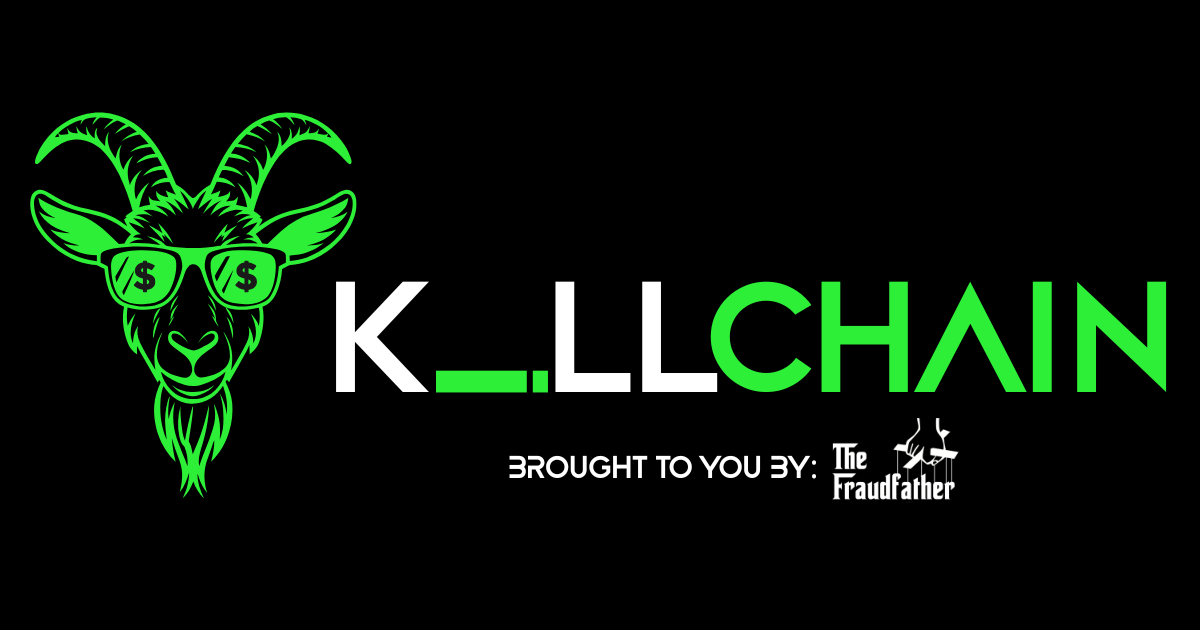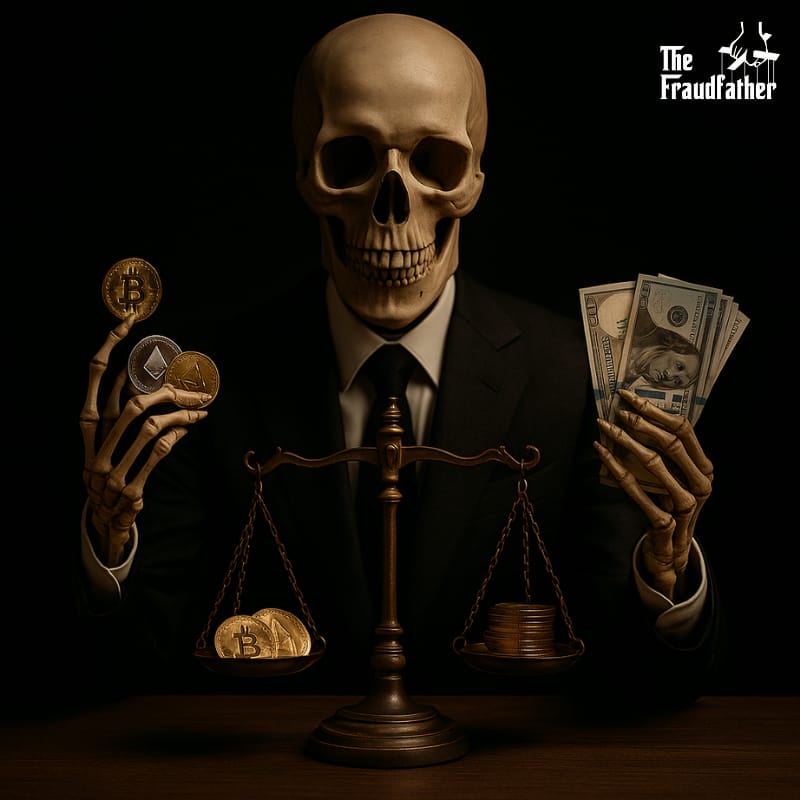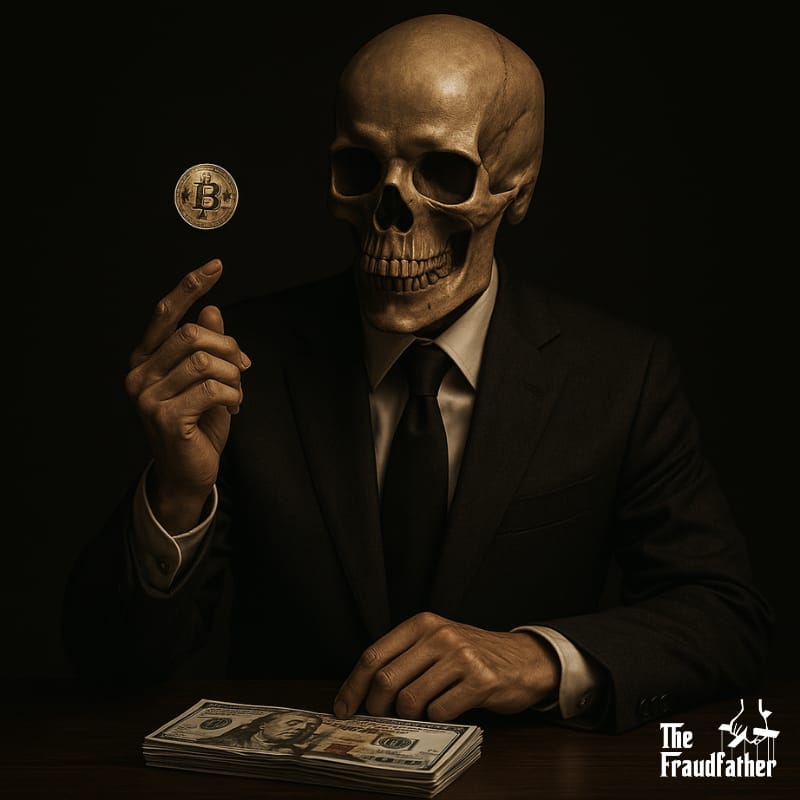- The KillChain
- Posts
- Welcome to the KillChain
Welcome to the KillChain
We’re your tactical edge in a world of protocol-level psyops and wallet warfare. Every week, we drop the real threat intel: names, vectors, TTPs, and psychological levers used by the smartest fraudsters on the chain.

GM. You’re reading KillChain, the tactical brief trusted by digital sleuths, fraud hunters, and crypto insiders who know the real game isn’t DeFi or CeFi—it’s deception.
We track the wallets, decode the scams, and expose the plays fraudsters pray you’ll miss. This isn’t crypto news. It’s threat intel.. We’re the last line of defense between your protocol and the wolves—your tactical edge in a world where trust is just another exploit.
🎙️ Welcome to KillChain
Where fraud gets hunted and wallets don’t lie.
The old myth said crypto was for nerds and libertarians. The new truth? It’s the currency of cartels, nation-states, and high-speed scammers with better branding than your favorite startup.
Once upon a time, on-chain crime was just the sandbox for hackers and darknet cowboys. Now? It’s the backbone of a new global shadow economy. From ransomware crews laundering millions, to foreign intelligence ops bypassing sanctions through stablecoins, crypto isn’t just part of the problem—it’s the infrastructure for it.
And here’s the twist that should keep you up at night:
Most of today’s fraud doesn’t even start on-chain. It starts with a fake tweet. A forged doc. A click.
But the exit plan? Always the same—on-chain, fast, and buried beneath layers of mixers, shell wallets, and fake protocols.
We’re not just tracking stolen funds and rugpulls.
We’re mapping the rise of fraud-as-a-service, a booming underground economy where entire toolkits are built to help bad actors wash dirty crypto like it’s a Tuesday errand.
KillChain exists because the old models can’t keep up.
Compliance is slow. Regulators are confused. And your audit trail won’t mean sh*t when you’re staring at a drained treasury.
That’s where we come in.
We’re your tactical edge in a world of protocol-level psyops and wallet warfare.
Every week, we drop the real threat intel: names, vectors, TTPs, and psychological levers used by the smartest fraudsters on the chain.
Why This Matters
Let’s set the record straight:
Crypto is not the enemy. Fraud is.
People love to point fingers at blockchains like they’re some digital Pandora’s box—but let’s not get it twisted. Humans have been committing fraud since Judas sold out for silver.
And fiat? Please. From Ponzi schemes to wire fraud, Bernie Madoff didn’t need an NFT to run the biggest scam on Wall Street.
Crypto isn’t the scam—it’s just the new getaway car.
And unlike the old days, this one leaves a trail. Every rugpull, every exit scam, every mixer hop—it’s all there if you know where (and how) to look.
That’s where KillChain comes in.
We’re not here to dunk on the tech. We’re here to expose the operators behind the exploits, the wallets behind the grifts, and the networks turning fraud into an industry.
Because if we don’t understand how fraud evolves, we can’t stop it.
And if we can’t stop it, it’s not just Web3 that’s at risk—it’s the entire future of financial sovereignty.
So don’t just read this newsletter.
Use it like a weapon.
Here’s what’s on this week’s op sheet:

Before You Worship the Coin, Understand the Altar
Before You Worship the Coin, Understand the Altar
Bitcoin maxis have a simple gospel: “Number go up.”
But before we count coins like misers on meth, let’s pause and ask a radical question:
What the hell is money?
Because if Bitcoin wants to dethrone the dollar, it first has to be money.
Not tech. Not code. Money.
And money, real money, isn’t just something you hodl.
It’s something the world uses when things get messy.
It’s what you reach for when you need to trade tanks for oil, or settle billion-dollar debts across oceans.
So let’s get uncomfortable and stare directly into the sun of power:
The U.S. dollar.
Why the Dollar Dominates: Anatomy of a Reserve Currency
If money is language, the dollar is Latin.
It’s the lingua franca of global trade, diplomacy, and financial warfare.
Roughly 90% of all foreign exchange transactions involve dollars.
Central banks, businesses, criminals, and governments across the globe reach for the greenback when they need to settle scores.
Why?
Because the dollar isn’t just a currency. It’s a weaponized instrument of trust.
And to reach that status, you need four things. Not vibes. Not X threads. Four iron pillars:
1. Liquidity – There Must Be Oceans, Not Puddles
If you want your currency to rule the world, there has to be a lot of it—changing hands fast, at scale, without setting the market on fire.
Take the U.S. Treasury market: $33 trillion deep. You can sell $100 billion worth in a day, and the market yawns.
Compare that to the Swiss franc. You try to drop $50 billion of Swiss bonds on the market, and you’ll crater it like a meteor.
Liquidity is power. Without it, your asset is just expensive art with no buyer.
2. Safety – A Store of Value, Not a Slot Machine
Reserve currencies must hold value.
That means no hyperinflation, no government-induced death spirals, and no "whoops, our economy collapsed overnight" scenarios.
You don’t get to be the world’s piggy bank if your money loses value faster than milk spoils.
3. Trust – Institutions That Don’t Flinch
This is where empires are made—or lost.
To trust a currency, you must trust its creators.
That means:
Checks and balances. No reckless fiscal benders.
Rule of law. No sudden “sorry, we’re not paying” rug pulls on foreign investors.
An independent central bank. Because if the money printer is in the hands of madmen, everyone dies holding worthless paper.
The dollar earned this trust through decades of global dominance, bloodshed, Bretton Woods agreements, and the sheer gravitational pull of U.S. military and economic might.
4. A Strong, Growing Economy – The Rising Tide That Lifts the Currency
Nobody wants to hold a currency backed by rot.
People want to hitch their wagon to a star—not a sinking ship.
America, for all its chaos, remains the engine of global growth, technological innovation, and consumer demand.
That matters. A lot.
🏛️ A Brief History of Monetary Thrones
The dollar wasn’t always king.
Before it, the British pound sterling held the crown—carried by an empire on which the sun never set.
Britain built global trade routes. The pound followed.
But empires rot.
And after World War I, the pound bled.
By World War II, the transition was sealed—not by market forces, but by fiat, at a little gathering in Bretton Woods, New Hampshire.
There, the victors of war built the rules of peace—and made the dollar the keystone of global commerce.
Currencies were pegged to the dollar. The dollar was pegged to gold.
The U.S. didn’t win the world’s trust. It wrote the contract.
And That’s What Bitcoin Is Up Against
Before you ask, “Why isn’t Bitcoin the world’s reserve currency yet?”—
Ask yourself:
Would you trust it to buy 100 tanks? Would a foreign government trust it to settle a $10B energy contract? Would a central bank trust it enough to stack it as collateral?
If the answer is no—then it’s not money.
Not yet.
Now let’s look at the battlefield.
Let’s compare BTC to gold, the euro, and the dollar.
Let’s see what it would actually take to be taken seriously.
👉 Scroll down. It gets bloody.
Looking for unbiased, fact-based news? Join 1440 today.
Join over 4 million Americans who start their day with 1440 – your daily digest for unbiased, fact-centric news. From politics to sports, we cover it all by analyzing over 100 sources. Our concise, 5-minute read lands in your inbox each morning at no cost. Experience news without the noise; let 1440 help you make up your own mind. Sign up now and invite your friends and family to be part of the informed.

Let’s drop the Hopium IV drip and look at the raw battlefield data.
Because for Bitcoin to become “serious,” it has to storm the gates of financial empire—and hold the territory.
So, How Does Bitcoin Actually Stack Up?
Let’s drop the Hopium IV drip and look at the raw battlefield data.
Because for Bitcoin to become “serious,” it has to storm the gates of financial empire—and hold the territory.
Here’s where we stand in May 2025:
Asset | Estimated Size (USD) | BTC Share vs Asset |
|---|---|---|
Bitcoin (BTC) | ~$2.13 trillion | - |
Gold | ~$15.9 trillion | ~13% |
Euro (reserves) | ~$2.3 trillion | ~93% |
USD (reserves) | ~$6.6 trillion | ~32% |
USD (M2 supply) | ~$25-30 trillion | ~7% |
Not bad for digital smoke. But still a rounding error in empire economics.
Want to Be Taken Seriously? Beat Gold.
If Bitcoin wants to wear the “store of value” crown, it needs to dethrone gold.
Target: $15 trillion market cap
Price per BTC: ~$750,000
Narrative: “Digital gold” for the surveillance age. A lifeboat from fiat rot and state censorship.
The problem? Gold has 5,000 years of institutional memory. BTC has 15 years of memes and margin calls. Bitcoin’s volatility is still too spicy for central banks.
Until a sovereign wealth fund says “yes,” this is a speculative asset class—not a pillar of monetary defense.
Want Respect? Become a Reserve Currency.
Bitcoin’s already larger than the euro’s reserve footprint in raw market cap.
But here’s the catch:
Not one single central bank officially holds Bitcoin. Not. One.
Because real reserve assets aren’t just held, they’re trusted to settle wars by wire transfer.
Bitcoin can’t get there until it solves the four fatal flaws:
Too volatile
Too complex
Too unregulated
Too many ransomware receipts in its resume
If BTC wants to sit in the vaults of sovereign nations, it has to stop looking like a hacker’s getaway car.
Want to Be Money? Act Like Money.
Here’s the harsh truth: People don’t spend Bitcoin. They speculate with it. That’s not a currency. That’s digital tulip futures.
To become a medium of exchange, Bitcoin needs:
Lightning-fast payments
Near-zero fees
Instant finality
Universal acceptance
Regulatory green lights
Instead, we get:
$9 network fees on a good day
Confusing wallets
Zero merchant adoption outside of boutique coffee shops and El Salvador’s PR budget
Bitcoin’s Real Enemies (They’re Not Who You Think)
Bitcoiners love to shout “The dollar is dying!”
But the dollar’s not shaking. It’s strategically evolving.
Meanwhile, BTC faces real adversaries:
Enemy | Why It’s a Problem |
|---|---|
Volatility | No one builds contracts or nations on chaos |
No Lender of Last Resort | Fiat has central banks. BTC has “vibes” |
CBDCs | State-backed rivals coming for the same turf |
Custody Risk | Grandma is still losing coins to fake Metamask wallets |
Regulators | Especially in the EU and U.S. and they have regulatory pens and prisons |
Fraudfather Thought: BTC Is a Weapon. But Not Yet a Sovereign One.
Bitcoin is a financial insurgency.
It’s clever. It’s global. It’s increasingly institutionalized.
But it’s not yet sovereign.
Until it gains:
Institutional trust
Reserve adoption
Currency-scale usability
…it remains a brilliant invention looking for a throne.
So ask yourself:
Do you want Bitcoin to make you rich? Or do you want it to rule?
Because the road to power is paved with more than price charts.
It’s built on liquidity, stability, trust, and fear.
And right now, Bitcoin’s got one out of four. Maybe.

New Signal in the Chain: MVRV Z-Score
Tracking When the Herd Loses Its Mind
This week marks the first inclusion of a powerful macro signal we’ll be monitoring regularly: the MVRV Z-Score.
What It Is
The MVRV Z-Score measures how over- or under-valued Bitcoin is relative to its historical cost basis, adjusted for volatility. Think of it as a heat gauge for crowd euphoria or despair.
Formula:
(Market Cap – Realized Cap) ÷ Standard Deviation of Market Cap
In plain terms:
Z-Score < 1 → Capitulation zone: Smart money buys here.
Z-Score 1–3 → Neutral zone: Wait, watch, accumulate cautiously.
Z-Score > 5 → Euphoria: Everyone’s drunk on green candles. Take cover.
This Week's Readout: 2.62
Bitcoin sits in the neutral-to-warm range. Price has surged above $104K, but on-chain sentiment isn’t yet frothy. Retail isn’t fully engaged, and whales aren’t dumping—yet.
Why We’re Including This
Too many influencers and Youtube prophtes scream “BUY THE DIP” or “SELL EVERYTHING” based on vibes and momentum. KillChain readers deserve better—data-driven awareness of where we are in the cycle.
The MVRV Z-Score cuts through noise. It tells us when:
Retail is aping in (top forming), or
Everyone’s bleeding out and selling at a loss (bottom forming).
This metric becomes lethal when paired with others like wallet growth by cohort (retail vs. whale) and exchange flows.
We’ll track it weekly from here on, because in war, as in markets, the side with better intel wins.
KillChain Threat Index
How hot is the fraud warzone today? We measure it. You weaponize it.
The KillChain Threat Index (KTI) is our weekly pulse check on the fraud warzone. Think of it like the Fear and Greed Index—but for cybercrime. It’s not just a number. It’s a battlefield readout.
Every day, we sweep across dark web chatter, blockchain exploits, phishing surges, wallet drains, and emerging fraud patterns. We condense that chaos into a single Threat Score so you can act before attackers strike.
When KTI rises, it means something’s brewing:
• Real-time scams are spiking
• Tools are being deployed in the wild
• Fraud rings are mobilizing
Use this index to:
Protect your wallet, your network, or your users
Predict when scams might peak
Understand the evolving tactics of fraudsters and hustlers
Weaponize intelligence, not just react to it
Because in fraud defense, timing is everything.
Threat Score: 74 – High Alert

Fraud vectors are flaring across multiple fronts. We’re seeing elevated signals on phishing activity, flash loan exploits, and dark web chatter.
🔵 0–20: Low Threat – Mostly script kiddies & amateur ops
🟢 21–50: Elevated Threat – Uptick in wallet drains, minor exploit chatter
🟡 51–70: High Threat – Real ops forming. Chain activity spiking.
🔴 71–90: Critical – Scams spreading, signature kits detected, real $$$ at risk
⚫️ 91–100: Blackout – Major exploit in progress. Protocol-level risk.

You may have heard that illicit crypto activity dropped in 2024.
Spoiler: It didn’t. That’s just the part we can see right now.
The $51 Billion Lie Hiding in Plain Sight
You may have heard that illicit crypto activity dropped in 2024.
Spoiler: It didn’t. That’s just the part we can see right now.
According to surface-level metrics, “only” $40.9 billion in value hit wallets tied to bad actors last year. Sounds like progress, right? Until you realize that these numbers are low-bound estimates—and the real flows are buried in still-undiscovered infrastructure.
Here’s how this game really works: In 2023, Chainalysis initially pegged illicit flows at $24.2B. A year later? That same number ballooned to $46.1B, once more laundering rings, shell wallets, and proxy services were uncovered.
Translation:
The deeper you dig, the darker it gets.
And 2024 is already showing signs it’ll blow past $51 billion once the full picture emerges.
Why? Because the fraud economy is professionalizing.
This isn’t a bunch of Discord teenagers with ledger wallets anymore. It’s criminal vendors, nation-state proxies, and laundering-as-a-service firms operating through platforms like Huione.
These aren’t transactions; they’re tactical maneuvers.
Bad actors are embedding themselves inside otherwise "clean" chains, using on-chain infrastructure for off-chain crime: sanctions evasion, drug money, cyber extortion, and institutional-scale fraud.
And here’s the punchline:
Most of it still looks clean on-chain.
Unless you’ve got off-chain intelligence or platform-level attribution, you're flying blind. It’s nearly impossible to distinguish a tainted transaction from a legit one, until it's too late.
KillChain isn’t here to count bodies after the ambush.
We’re here to map the terrain before the breach. Every week, we’ll arm you with the signals, vectors, and behavioral footprints that separate real operators from regulatory theater.
Because the biggest threat to crypto isn’t volatility.
It’s the illusion that everything’s under control.

KillChain Operator Tips: Stay Untouchable
Quick-hitting, tactical steps to make yourself a harder target.
These aren’t just suggestions. They’re battle-proven protocols.
Don’t click QR codes from Twitter/X. Ever.
Why? QR codes can be weaponized. Scammers often embed links that drain your wallet or trick you into signing malicious transactions. If you must use one, verify it through trusted sources—not some rando’s thread or giveaway post.
Red flag: If the QR code promises free tokens, whitelist access, or VIP status, it’s bait.
Set token spend limits. Use revoke.cash weekly.
Why? When you connect your wallet to a site, you might give it unlimited spending power on your tokens. If that site gets hacked, so do you. Revoke.cash lets you see and cancel those hidden permissions.
Think of it like cutting spare keys you gave out, but forgot.
Simulate transactions (Blockaid, Blowfish, etc).
Why? Before you click “Confirm,” simulate it. These tools tell you exactly what the transaction will do, so you don’t accidentally sign away your NFTs or give approval to a malicious contract.
Trust the preview, not the promise. A flashy UI can lie. The simulation won't.
Use burner wallets for minting or airdrops.
Why? Mints and airdrops are high-risk zones. Smart contracts tied to them can contain hidden clauses. A burner wallet limits the blast radius. Keep only what you’re willing to lose in it.
Treat a mint wallet like a rental car in a warzone. Disposable. Controlled. Separate.
Auto-flag Telegram groups with “anti-revoke” or “sweeper bot” mentions.
Why? Scam networks often coordinate on Telegram. If you see discussions about “anti-revoke” (code to stop users from removing wallet permissions) or “sweeper bots” (scripts that steal assets instantly), you’re in hostile territory.
When they talk like hackers, assume they act like them. Leave. Report. Block.
The Fraudfather didn’t learn fraud from books.
He learned it chasing terrorists, flipping money launderers, and dismantling multi-million-dollar schemes, before most people knew what “DeFi” meant.
A former Senior Special Agent and Supervisory Intelligence Operations Officer, he spent over two decades tracking financial predators across borders, blockchains, and bureaucracies. From dark web forums to government war rooms, he’s seen every lie and loophole up close.
Now a “recovering” digital identity and cybersecurity executive, he’s turned his sights to teaching crypto, where old scams wear new skins, and smart contracts get played like slot machines.
Through The Fraudfather persona, he’s exposing how fraud really works on-chain:
– How social engineers bypass wallet security
– How cross-chain laundering pipelines stay hidden
– How scammers weaponize human psychology faster than regulators can blink
This isn’t theory.
It’s operational intelligence—on-chain and in real time.
Follow the Fraudfather and stay five moves ahead of the next exploit.
Fast Facts Regarding the Fraudfather:
Global Adventures: He’s been kidnapped in two different countries—but not kept for more than a day.
Uncommon Encounter: Former President Bill Clinton made him a protein shake.
Unusual Transactions: He inadvertently bought and sold a surface-to-air missile system.
Perpetual Patience: He spent 12 hours in an elevator.
Unique Conversations: He spoke one-on-one with Pope Francis for five minutes using reasonable Spanish.
Uncommon Hobbies: He discussed beekeeping with James Hetfield from Metallica.
Passion for Teaching: He taught teenagers archery in the town center of Kyiv, Ukraine.
Unlikely Math: Until the age of 26, he had taken off in a plane more times than he had landed.

